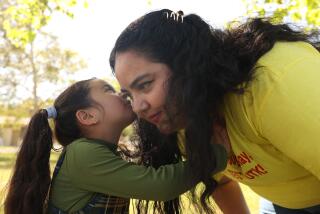Researchers Have Eye on Students in Linking Vision to Reading Success
- Share via
About 100 youngsters at Arnaz Elementary School in Oak View may serve as guinea pigs in a study of the link between vision and reading success, providing information that one day could help children overcome reading disabilities, Principal Nancy Barker said.
If the Ventura school board approves the plan, the children will read passages on a computer screen to assess eye movements and light sensitivity. Reading researcher Teri A. B. Lawton will use the results to determine whether there is a connection between the way children move their eyes as they read and how well they comprehend, Barker said.
“It’s time educators and scientists came together to ask, ‘How does this work?’ ” Barker said. “Reading is such a complex task. It’s not just looking at letters and hearing sounds.”
Barker and Lawton will explain the proposal to the Ventura school board tonight and ask for approval to move ahead at the next scheduled board meeting Aug. 22. The study will focus on students in kindergarten and second and third grades. Children will need parental permission to participate, Barker said.
Barker learned about the project when Lawton, a Casitas Springs resident, came to Arnaz last month to enroll one of her two children. The project sounded worthwhile, Barker said, so she agreed to approach the Ventura school board about using Arnaz students.
“I am definitely interested in the subject,” said Barker, who holds degrees in speech and language. “I would like to see advanced technologies applied to more classrooms.”
Lawton, a researcher with an imaging technology company, received a grant from the Jet Propulsion Laboratory at Caltech in Pasadena to begin the study, Barker said. Lawton will limit her initial research to Arnaz students, Barker said, but she hopes to conduct a larger study afterward.
If the proposal is approved by the school board, the Arnaz students would be screened three at a time in 15-minute sessions, Barker said. Each student will sit in front of a specially equipped computer and watch text roll across the screen, she said.
Each student must then indicate which direction the passage is moving, left or right, by pushing a button on the computer’s keyboard. Students who cannot read will look at simple patterns and say which way they are going, Barker said.
To ensure that a youngster does not confuse left and right, Lawton marked the computer buttons with large directional arrows. Lawton will also test light sensitivity by gradually dimming the letters on the computer screen and bringing them closer together, Barker said.
The principal stressed that Lawton’s study is not meant to diagnose learning disabilities. The researcher’s only intent is to collect data and report the results, Barker said.
Lawton will inform the Ventura school board of her results in December, she said. All information on individual students will be kept confidential, even from parents of the participants, Barker said.
“We don’t want them to think that this is some kind of diagnosis,” she said. “We are not medical doctors.”
School board member Diane Harriman believes the study is a good idea. A former teacher, Harriman said she believes individual students have different learning styles, including reading skills.
“A lot of kids are not visual learners,” Harriman said. “They learn by what they hear.”
The results also might be used to support a return to phonics in teaching young children how to read, Harriman said. The current state curriculum takes the whole-language approach to reading, which involves teaching children whole words at a time instead of breaking them into syllables.
More to Read
Sign up for Essential California
The most important California stories and recommendations in your inbox every morning.
You may occasionally receive promotional content from the Los Angeles Times.














